Abstract
The impact of recombinant human tumour necrosis factor-alpha (1 microgram kg-1 to 1 mg kg-1; 6.6 x 10(6) U mg protein-1) on blood flow, oxygen consumption and growth of a moderately TNF-sensitive rat tumour (DS-carcinosarcoma) was studied. Tumour growth was stimulated at low TNF doses (1 and 10 micrograms kg-1) and significantly retarded at higher TNF dose levels (0.1 and 1 mg kg-1). Growth changes were concomitant with variations in oxygen consumption, lactate release and acidification of the metabolic micromilieu. Both single and repeated application of low TNF doses (1-10 micrograms kg-1 i.v.) increased tumour perfusion whereas single administration of high TNF dose levels (0.1-1 mg kg-1 i.v.) reduced tumour blood flow. After repeated application of high TNF doses tumours shrank to such small sizes that perfusion measurements could not be performed within the observation period of two weeks. It is concluded that TNF effects on solid tumours are at least partially mediated by changes in tumour perfusion. Thus, an altered tumour sensitivity towards other treatment modalities, e.g. irradiation, chemotherapy or hyperthermia, can be expected after TNF therapy. A beneficial TNF effect would critically depend on the dose level employed and on the sequence and timing of various combination regimes.
Full text
PDF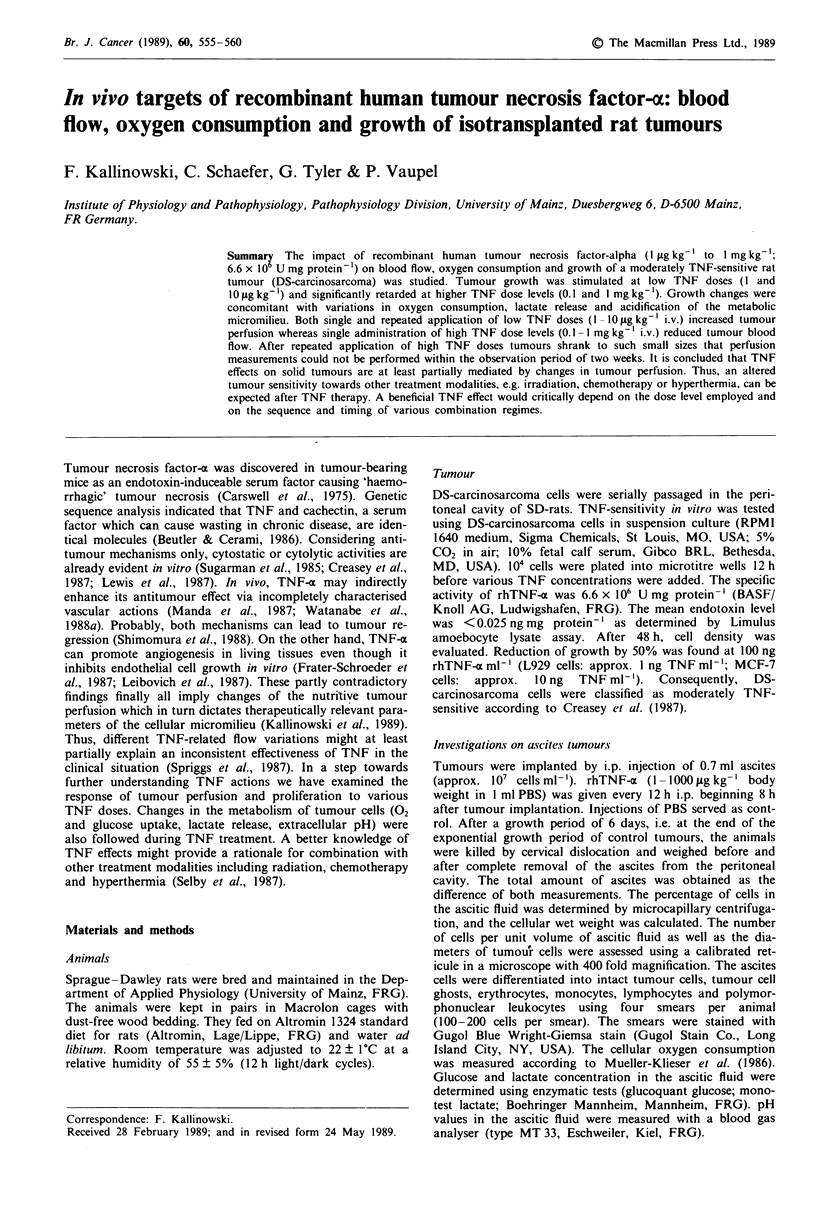

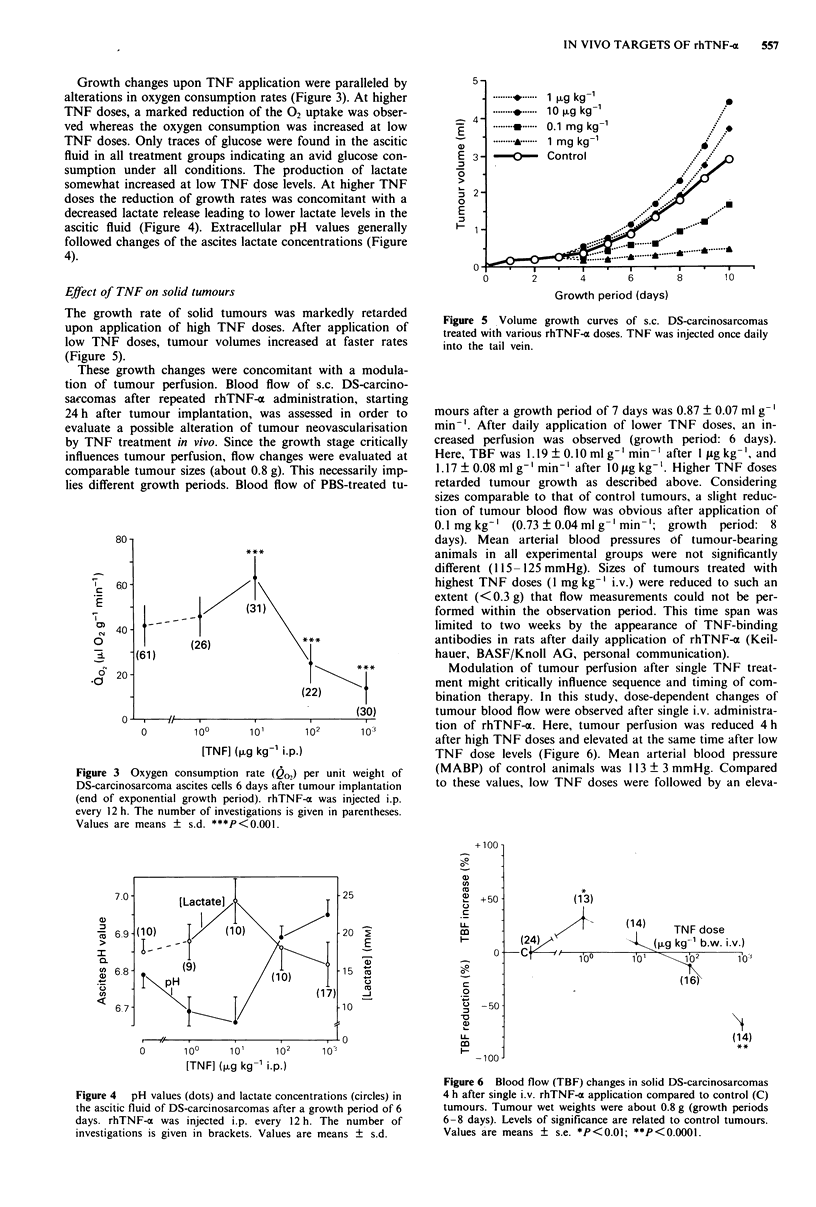
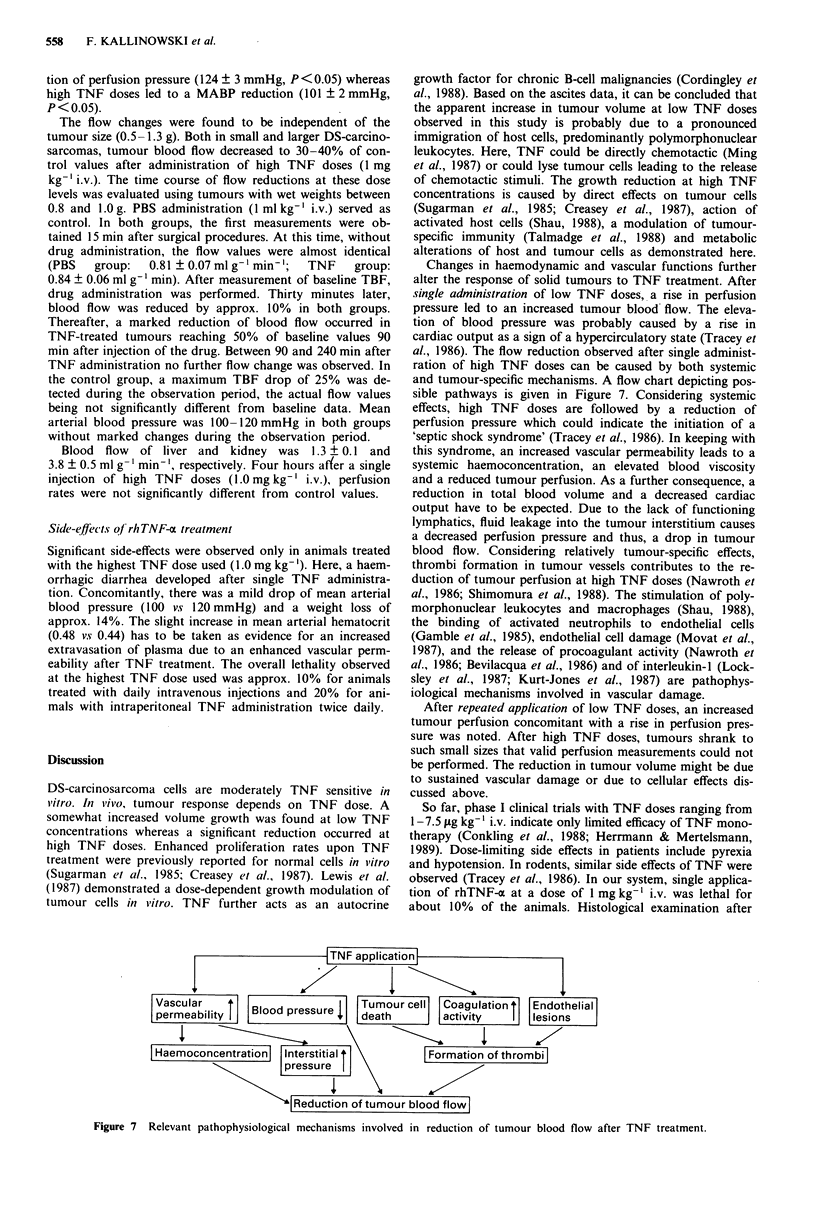
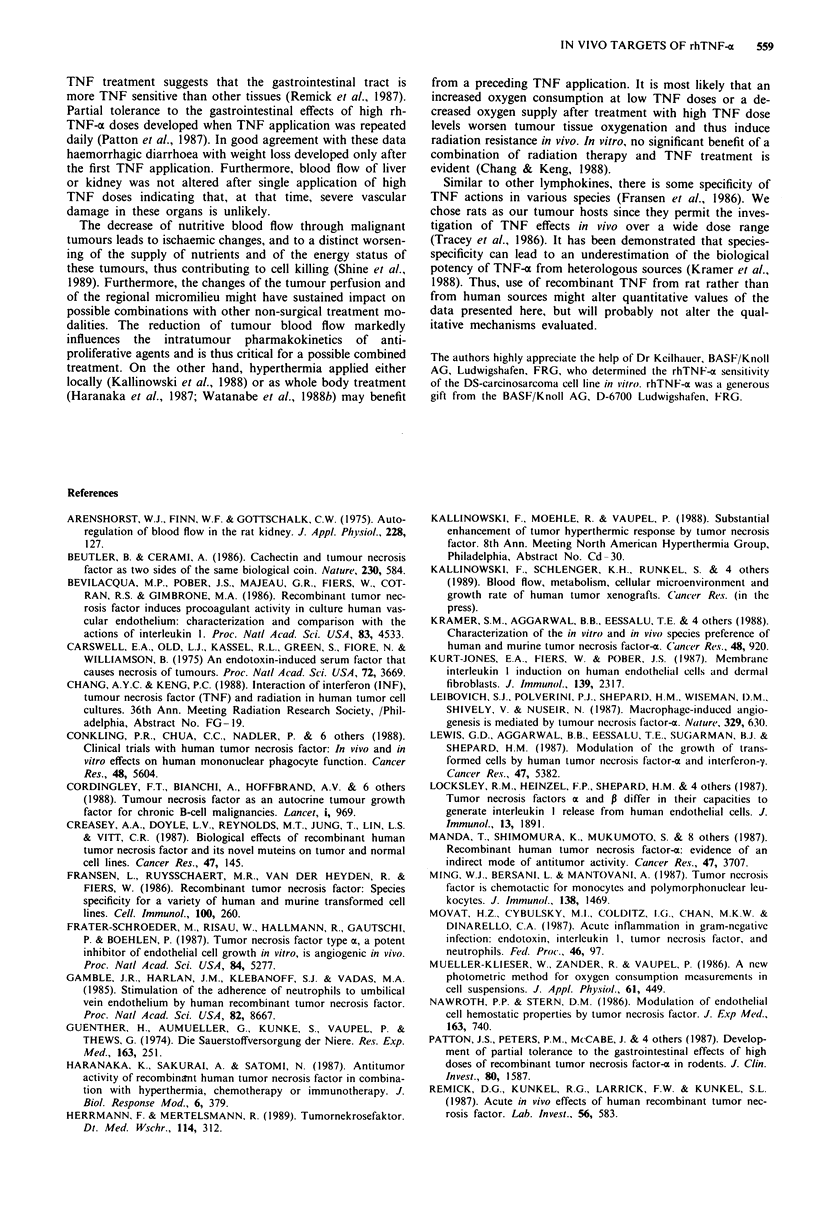
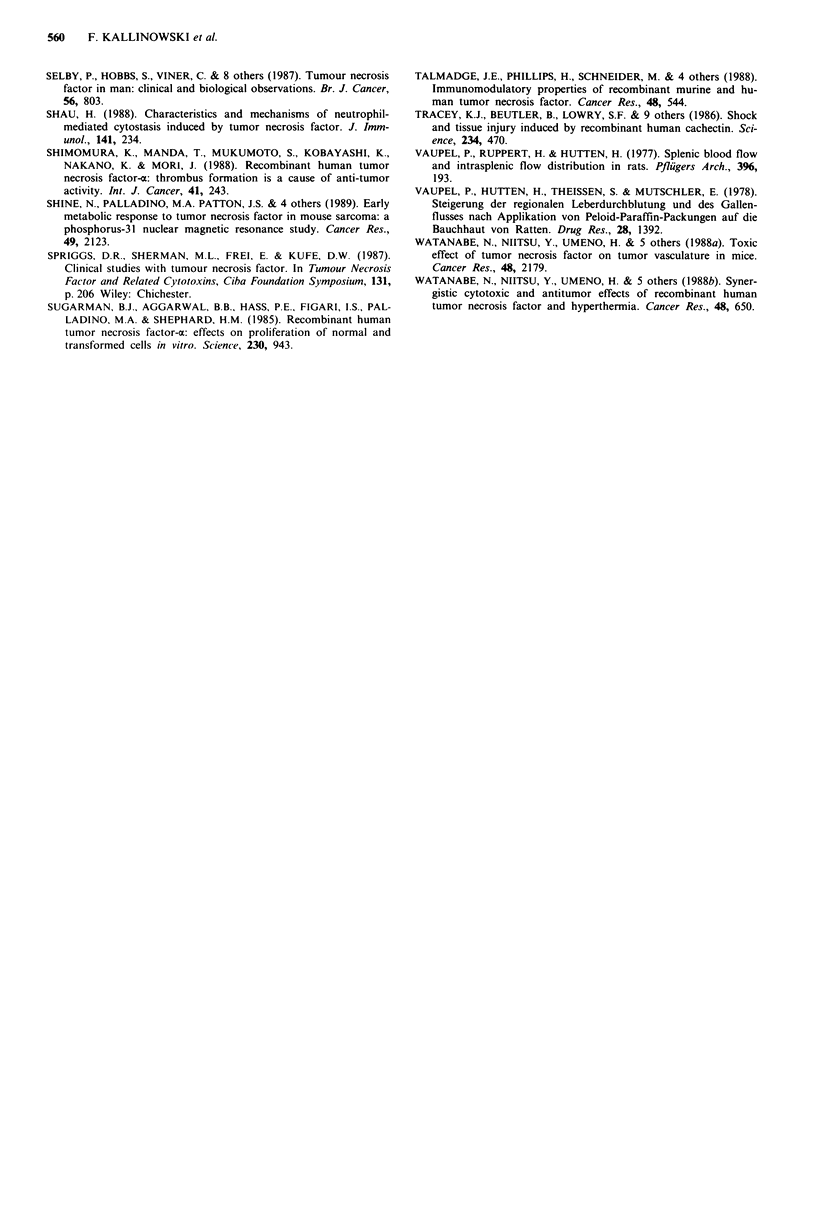
Selected References
These references are in PubMed. This may not be the complete list of references from this article.
- Arendshorst W. J., Finn W. F., Gottschalk C. W. Autoregulation of blood flow in the rat kidney. Am J Physiol. 1975 Jan;228(1):127–133. doi: 10.1152/ajplegacy.1975.228.1.127. [DOI] [PubMed] [Google Scholar]
- Beutler B., Cerami A. Cachectin and tumour necrosis factor as two sides of the same biological coin. Nature. 1986 Apr 17;320(6063):584–588. doi: 10.1038/320584a0. [DOI] [PubMed] [Google Scholar]
- Bevilacqua M. P., Pober J. S., Majeau G. R., Fiers W., Cotran R. S., Gimbrone M. A., Jr Recombinant tumor necrosis factor induces procoagulant activity in cultured human vascular endothelium: characterization and comparison with the actions of interleukin 1. Proc Natl Acad Sci U S A. 1986 Jun;83(12):4533–4537. doi: 10.1073/pnas.83.12.4533. [DOI] [PMC free article] [PubMed] [Google Scholar]
- Conkling P. R., Chua C. C., Nadler P., Greenberg C. S., Doty E., Misukonis M. A., Haney A. F., Bast R. C., Jr, Weinberg J. B. Clinical trials with human tumor necrosis factor: in vivo and in vitro effects on human mononuclear phagocyte function. Cancer Res. 1988 Oct 1;48(19):5604–5609. [PubMed] [Google Scholar]
- Cordingley F. T., Bianchi A., Hoffbrand A. V., Reittie J. E., Heslop H. E., Vyakarnam A., Turner M., Meager A., Brenner M. K. Tumour necrosis factor as an autocrine tumour growth factor for chronic B-cell malignancies. Lancet. 1988 Apr 30;1(8592):969–971. doi: 10.1016/s0140-6736(88)91782-5. [DOI] [PubMed] [Google Scholar]
- Creasey A. A., Doyle L. V., Reynolds M. T., Jung T., Lin L. S., Vitt C. R. Biological effects of recombinant human tumor necrosis factor and its novel muteins on tumor and normal cell lines. Cancer Res. 1987 Jan 1;47(1):145–149. [PubMed] [Google Scholar]
- Fransen L., Ruysschaert M. R., Van der Heyden J., Fiers W. Recombinant tumor necrosis factor: species specificity for a variety of human and murine transformed cell lines. Cell Immunol. 1986 Jun;100(1):260–267. doi: 10.1016/0008-8749(86)90025-0. [DOI] [PubMed] [Google Scholar]
- Fràter-Schröder M., Risau W., Hallmann R., Gautschi P., Böhlen P. Tumor necrosis factor type alpha, a potent inhibitor of endothelial cell growth in vitro, is angiogenic in vivo. Proc Natl Acad Sci U S A. 1987 Aug;84(15):5277–5281. doi: 10.1073/pnas.84.15.5277. [DOI] [PMC free article] [PubMed] [Google Scholar]
- Gamble J. R., Harlan J. M., Klebanoff S. J., Vadas M. A. Stimulation of the adherence of neutrophils to umbilical vein endothelium by human recombinant tumor necrosis factor. Proc Natl Acad Sci U S A. 1985 Dec;82(24):8667–8671. doi: 10.1073/pnas.82.24.8667. [DOI] [PMC free article] [PubMed] [Google Scholar]
- Günther H., Aumüller G., Kunke S., Vaupel P., Thews G. Die Sauerstoffversorgung der Niere. I. Verteilung der O2-Drucke in der Rattenniere unter Normbedingungen. Res Exp Med (Berl) 1974 Jul 4;163(3):251–264. doi: 10.1007/BF01851672. [DOI] [PubMed] [Google Scholar]
- Haranaka K., Sakurai A., Satomi N. Antitumor activity of recombinant human tumor necrosis factor in combination with hyperthermia, chemotherapy, or immunotherapy. J Biol Response Mod. 1987 Aug;6(4):379–391. [PubMed] [Google Scholar]
- Herrmann F., Mertelsmann R. Tumornekrosefaktor. Dtsch Med Wochenschr. 1989 Feb 24;114(8):312–316. doi: 10.1055/s-0029-1235647. [DOI] [PubMed] [Google Scholar]
- Kramer S. M., Aggarwal B. B., Eessalu T. E., McCabe S. M., Ferraiolo B. L., Figari I. S., Palladino M. A., Jr Characterization of the in vitro and in vivo species preference of human and murine tumor necrosis factor-alpha. Cancer Res. 1988 Feb 15;48(4):920–925. [PubMed] [Google Scholar]
- Kurt-Jones E. A., Fiers W., Pober J. S. Membrane interleukin 1 induction on human endothelial cells and dermal fibroblasts. J Immunol. 1987 Oct 1;139(7):2317–2324. [PubMed] [Google Scholar]
- Leibovich S. J., Polverini P. J., Shepard H. M., Wiseman D. M., Shively V., Nuseir N. Macrophage-induced angiogenesis is mediated by tumour necrosis factor-alpha. Nature. 1987 Oct 15;329(6140):630–632. doi: 10.1038/329630a0. [DOI] [PubMed] [Google Scholar]
- Lewis G. D., Aggarwal B. B., Eessalu T. E., Sugarman B. J., Shepard H. M. Modulation of the growth of transformed cells by human tumor necrosis factor-alpha and interferon-gamma. Cancer Res. 1987 Oct 15;47(20):5382–5385. [PubMed] [Google Scholar]
- Locksley R. M., Heinzel F. P., Shepard H. M., Agosti J., Eessalu T. E., Aggarwal B. B., Harlan J. M. Tumor necrosis factors alpha and beta differ in their capacities to generate interleukin 1 release from human endothelial cells. J Immunol. 1987 Sep 15;139(6):1891–1895. [PubMed] [Google Scholar]
- Manda T., Shimomura K., Mukumoto S., Kobayashi K., Mizota T., Hirai O., Matsumoto S., Oku T., Nishigaki F., Mori J. Recombinant human tumor necrosis factor-alpha: evidence of an indirect mode of antitumor activity. Cancer Res. 1987 Jul 15;47(14):3707–3711. [PubMed] [Google Scholar]
- Ming W. J., Bersani L., Mantovani A. Tumor necrosis factor is chemotactic for monocytes and polymorphonuclear leukocytes. J Immunol. 1987 Mar 1;138(5):1469–1474. [PubMed] [Google Scholar]
- Movat H. Z., Cybulsky M. I., Colditz I. G., Chan M. K., Dinarello C. A. Acute inflammation in gram-negative infection: endotoxin, interleukin 1, tumor necrosis factor, and neutrophils. Fed Proc. 1987 Jan;46(1):97–104. [PubMed] [Google Scholar]
- Mueller-Klieser W., Zander R., Vaupel P. A new photometric method for oxygen consumption measurements in cell suspensions. J Appl Physiol (1985) 1986 Aug;61(2):449–455. doi: 10.1152/jappl.1986.61.2.449. [DOI] [PubMed] [Google Scholar]
- Nawroth P. P., Stern D. M. Modulation of endothelial cell hemostatic properties by tumor necrosis factor. J Exp Med. 1986 Mar 1;163(3):740–745. doi: 10.1084/jem.163.3.740. [DOI] [PMC free article] [PubMed] [Google Scholar]
- Patton J. S., Peters P. M., McCabe J., Crase D., Hansen S., Chen A. B., Liggitt D. Development of partial tolerance to the gastrointestinal effects of high doses of recombinant tumor necrosis factor-alpha in rodents. J Clin Invest. 1987 Dec;80(6):1587–1596. doi: 10.1172/JCI113245. [DOI] [PMC free article] [PubMed] [Google Scholar]
- Remick D. G., Kunkel R. G., Larrick J. W., Kunkel S. L. Acute in vivo effects of human recombinant tumor necrosis factor. Lab Invest. 1987 Jun;56(6):583–590. [PubMed] [Google Scholar]
- Selby P., Hobbs S., Viner C., Jackson E., Jones A., Newell D., Calvert A. H., McElwain T., Fearon K., Humphreys J. Tumour necrosis factor in man: clinical and biological observations. Br J Cancer. 1987 Dec;56(6):803–808. doi: 10.1038/bjc.1987.294. [DOI] [PMC free article] [PubMed] [Google Scholar]
- Shau H. Characteristics and mechanism of neutrophil-mediated cytostasis induced by tumor necrosis factor. J Immunol. 1988 Jul 1;141(1):234–240. [PubMed] [Google Scholar]
- Shimomura K., Manda T., Mukumoto S., Kobayashi K., Nakano K., Mori J. Recombinant human tumor necrosis factor-alpha: thrombus formation is a cause of anti-tumor activity. Int J Cancer. 1988 Feb 15;41(2):243–247. doi: 10.1002/ijc.2910410215. [DOI] [PubMed] [Google Scholar]
- Shine N., Palladino M. A., Jr, Patton J. S., Deisseroth A., Karczmar G. S., Matson G. B., Weiner M. W. Early metabolic response to tumor necrosis factor in mouse sarcoma: a phosphorus-31 nuclear magnetic resonance study. Cancer Res. 1989 Apr 15;49(8):2123–2127. [PubMed] [Google Scholar]
- Spriggs D. R., Sherman M. L., Frei E., 3rd, Kufe D. W. Clinical studies with tumour necrosis factor. Ciba Found Symp. 1987;131:206–227. doi: 10.1002/9780470513521.ch14. [DOI] [PubMed] [Google Scholar]
- Sugarman B. J., Aggarwal B. B., Hass P. E., Figari I. S., Palladino M. A., Jr, Shepard H. M. Recombinant human tumor necrosis factor-alpha: effects on proliferation of normal and transformed cells in vitro. Science. 1985 Nov 22;230(4728):943–945. doi: 10.1126/science.3933111. [DOI] [PubMed] [Google Scholar]
- Talmadge J. E., Phillips H., Schneider M., Rowe T., Pennington R., Bowersox O., Lenz B. Immunomodulatory properties of recombinant murine and human tumor necrosis factor. Cancer Res. 1988 Feb 1;48(3):544–550. [PubMed] [Google Scholar]
- Tracey K. J., Beutler B., Lowry S. F., Merryweather J., Wolpe S., Milsark I. W., Hariri R. J., Fahey T. J., 3rd, Zentella A., Albert J. D. Shock and tissue injury induced by recombinant human cachectin. Science. 1986 Oct 24;234(4775):470–474. doi: 10.1126/science.3764421. [DOI] [PubMed] [Google Scholar]
- Vaupel P., Hutten H., Theissen S., Mutschler E. Steigerung der regionalen Leberdurchblutung und des Galleflusses nach Applikation von Peloid-Paraffin-Packungen auf die Bauchhaut von Ratten. Arzneimittelforschung. 1978;28(8):1392–1398. [PubMed] [Google Scholar]
- Vaupel P., Ruppert H., Hutten H. Splenic blood flow and intrasplenic flow distribution in rats. Pflugers Arch. 1977 Jul 19;369(3):193–201. doi: 10.1007/BF00582184. [DOI] [PubMed] [Google Scholar]
- Watanabe N., Niitsu Y., Umeno H., Kuriyama H., Neda H., Yamauchi N., Maeda M., Urushizaki I. Toxic effect of tumor necrosis factor on tumor vasculature in mice. Cancer Res. 1988 Apr 15;48(8):2179–2183. [PubMed] [Google Scholar]
- Watanabe N., Niitsu Y., Umeno H., Sone H., Neda H., Yamauchi N., Maeda M., Urushizaki I. Synergistic cytotoxic and antitumor effects of recombinant human tumor necrosis factor and hyperthermia. Cancer Res. 1988 Feb 1;48(3):650–653. [PubMed] [Google Scholar]


